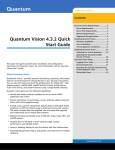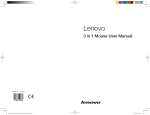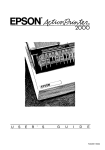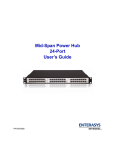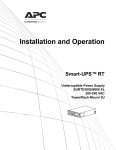Download LongView® Wireless
Transcript
LongView® Wireless Installer/User Guide INSTRUCTIONS This symbol is intended to alert the user to the presence of important operating and maintenance (servicing) instructions in the literature accompanying the appliance. DANGEROUS VOLTAGE This symbol is intended to alert the user to the presence of uninsulated dangerous voltage within the product’s enclosure that may be of sufficient magnitude to constitute a risk of electric shock to persons. PROTECTIVE GROUNDING TERMINAL This symbol indicates a terminal which must be connected to earth ground prior to making any other connections to the equipment. LongView® Wireless Installer/User Guide Avocent, the Avocent logo, The Power of Being There and LongView are registered trademarks of Avocent Corporation or its affliates. All other marks are the property of their respective owners. © 2004 Avocent Corporation. All rights reserved. USA Notification Warning: Changes or modifications to this unit not expressly approved by the party responsible for compliance could void the user’s authority to operate the equipment. Note: This equipment has been tested and found to comply with the limits for a Class A digital device, pursuant to Part 15 of the FCC Rules. These limits are designed to provide reasonable protection against harmful interference when the equipment is operated in a commercial environment. This equipment generates, uses and can radiate radio frequency energy and, if not installed and used in accordance with the instructions, may cause harmful interference to radio communications. Operation of this equipment in a residential area is likely to cause harmful interference, in which case the user will be required to correct the interference at his own expense. Canadian Notification This digital apparatus does not exceed the Class A limits for radio noise emissions from digital apparatus set out in the Radio Interference Regulations of the Canadian Department of Communications. Le présent appareil numérique n’émet pas de bruits radioélectriques dépassant les limites applicables aux appareils numériques de la classe A prescrites dans le Règlement sur le brouillage radioélectrique édicté par le Ministère des Communications du Canada. Safety and EMC Standards FCC class A, UL, cUL Table of Contents Chapter 1: Product Overview Features and Benefits . . . . . . . . . . . . . . . . . . . . . . . . . 3 Compatibility with Peripherals . . . . . . . . . . . . . . . . 5 Safety Precautions . . . . . . . . . . . . . . . . . . . . . . . . . . . 5 Chapter 2: Installation Getting Started . . . . . . . . . . . . . . . . . . . . . . . . . . . . . . 9 Installing a LongView Wireless Extender . . . . . . . 10 Chapter 3: Operations Powering the LongView Wireless Extender . . . . . . 15 Informational Messages . . . . . . . . . . . . . . . . . . . . . 15 LEDs . . . . . . . . . . . . . . . . . . . . . . . . . . . . . . . . . . . . . 16 Fine-Tuning the Image Settings . . . . . . . . . . . . . . . 16 Image Adjustment Using the LongView Wireless Extender OSD . . . . . . . 17 Appendices Appendix A: Technical Specifications . . . . . . . . . . 21 Appendix B: Technical Support . . . . . . . . . . . . . . . 22 Appendix C: Troubleshooting . . . . . . . . . . . . . . . . . 23 1 Product Overview Contents Features and Benefits . . . . . . . . . . . . . . . . . . . . . . . . . 3 Compatibility with Peripherals . . . . . . . . . . . . . . . . 5 Safety Precautions . . . . . . . . . . . . . . . . . . . . . . . . . . . 5 Chapter 1: Product Overview 3 Chapter 1: Product Overview Features and Benefits The Avocent LongView® Wireless extender connects Keyboard, Video, Mouse (KVM) and audio peripherals wirelessly to your computer, from up to 100 feet away. The LongView Wireless extender is a digital system that processes analog video, inbound and outbound, utilizing a unique, proprietary compression engine. At the heart of the compression engine is a multimedia DSP and an FPGA that are coupled to an IEEE 802.11a radio board. Its industry standard design makes the LongView Wireless extender compatible with virtually any PC, display technology and operating system. Installation is essentially Plug and Play requiring no new drivers or software. S1 S2 PWR Figure 1.1: LongView Wireless Extender Model The LongView Wireless extender On-Screen Display (OSD) The LongView Wireless extender OSD makes it simple to set up and adjust your video parameters. Accessed from the receiver side, the OSD makes tuning your video fast and convenient. 4 LongView Wireless Installer/User Guide Extended Access User LongView Wireless Receiver LongView Wireless Transmitter Server Figure 1.2: Example LongView Wireless Extender Configuration Secure connectivity and 802.11a standards-based design Advanced Encryption Standard (AES) provides secure connections through a proprietary design based on the 802.11a standard. The LongView Wireless transmitter The LongView Wireless transmitter connects directly to your computer and serves as the radio interface device enabling the computer to transmit audio and video data. It also acts as the receiver for keyboard and mouse signals from extended devices. The LongView Wireless transmitter contains five chassis-mounted connectors for local video, keyboard and mouse peripherals, in addition to power and audio in from the computer. It includes a 3.5 foot cable with video and PS/2 keyboard and mouse connectors. Power is supplied to the transmitter from a universal input 12 V DC switching power supply (included). The LongView Wireless receiver The LongView Wireless receiver connects directly to your user interface devices (keyboard, video monitor and mouse) and serves as the radio interface device for these components. It receives audio and video data from the source computer and sends keyboard and mouse data from the user interface devices to the source computer. The LongView Wireless receiver has five chassis-mounted connectors for video, keyboard, mouse and audio peripherals and power. Power is supplied to the transmitter from a universal input 12 V DC switching power supply (included). Chapter 1: Product Overview 5 Compatibility with Peripherals The LongView Wireless extender is compatible with the following peripherals: • Keyboard- The LongView Wireless transmitter and receiver support virtually any standard PS/2 keyboard. • Mouse- The LongView Wireless transmitter and receiver support 2button PS/2 mice. Mice that have more than two buttons work with the reduced functionality of a 2-button mouse. • Video- The LongView Wireless extender supports VGA, SVGA and XGA resolutions up to 60 Hz refresh rate. Both CRT and LCD monitors with standard 15-pin high density connectors are supported. • Audio- Speakers and headphones with 3.5 mm audio plugs are supported on the receiver side of your LongView Wireless extender, provided the transmitter has been connected to the sound card of your PC with the provided audio cable. Safety Precautions To avoid potential video and/or keyboard problems when using Avocent products: • If the building has 3-phase AC power, ensure that the computer and monitor are on the same phase. For best results, they should be on the same circuit. • Use only Avocent-supplied cable to connect computers and KVM switches. Avocent warranties do not apply to damage resulting from user-supplied cable. To avoid potentially fatal shock hazard and possible damage to equipment, please observe the following precautions: • Do not use a 2-wire extension cord in any Avocent product configuration. • Test AC outlets at the computer and monitor for proper polarity and grounding. • Use only with grounded outlets at both the computer and monitor. When using a backup Uniterruptible Power Supply (UPS), power the computer and the LongView Wireless transmitter unit off the supply. NOTE: The AC inlet is the main disconnect. 6 LongView Wireless Installer/User Guide 2 Installation Contents Getting Started . . . . . . . . . . . . . . . . . . . . . . . . . . . . . . 9 Installing a LongView Wireless Extender . . . . . . . 10 Chapter 2: Installation 9 Chapter 2: Installation Getting Started Before installing your LongView Wireless extender, refer to the list below to ensure that you have all the items that shipped with the product. Supplied with the LongView Wireless extender • LongView Wireless transmitter • LongView Wireless receiver • Two local country power supplies • Audio cable • LongView Wireless Installer/User Guide • LongView Wireless Quick Installation Guide 10 LongView Wireless Installer/User Guide Installing a LongView Wireless Extender Follow the procedures in the To install a LongView Wireless transmitter and To install a LongView Wireless receiver sections to properly install your new KVM extension system. WARNING: To reduce the risk of electric shock or damage to your equipment Disconnect the power from the unit by unplugging the power supply from the electrical outlet. To install a LongView Wireless transmitter: 1. Ensure that the video setting of your computer is 1024 x 768, 800 x 600 or 640 x 480 at 60 Hz refresh rate. Best performance will be achieved if the color resolution is set to 24 bit color or higher. 2. Power down the computer that will be connected to your LongView Wireless extender. 3. Unplug the peripherals (keyboard, mouse, monitor and speakers with built-in amplifiers, if applicable) from your computer. Transmitter Cables Power Supply Peripheral Cables Audio Cable Figure 2.1: LongView Wireless Transmitter Installation Example Chapter 2: Installation 11 4. Prepare locations for your LongView Wireless extender equipment, computer and peripherals. Place the transmitter near your computer. Best performance is achieved when the antennas are clearly visible and free from obstructions. 5. Connect the LongView Wireless transmitter cables into the computer’s PS/2 keyboard (purple connector), PS/2 mouse (green connector) and monitor connections (blue connector). 6. Using the supplied audio cable, connect one end to the LongView Wireless transmitter’s audio input connection (lime green connector) and the other end to the computer’s audio output connection (lime green connector). 7. Connect your LongView Wireless transmitter to an AC power source with one of the power supplies included with your LongView Wireless extender. NOTE: The transmitter must be powered up before the computer. NOTE: Use only an Avocent-supplied power supply. 8. Power up your computer. Connecting the LongView Wireless receiver Virtually any industry-standard display device can be attached to the LongView Wireless receiver, as long as it has a 15-pin D shell connector for video input and can accept VGA (640 x 480), SVGA (800 x 600) and XGA (1024 x 768) resolution video. To install a LongView Wireless receiver: 1. Select a location for your LongView Wireless receiver. Find a convenient position for locating the LongView Wireless receiver, such as a desktop that is near your extended display. Best performance is achieved when the antennas are clearly visible and free from obstructions. 2. Connect the extended display’s video input into the LongView Wireless receiver’s video input (blue connector). NOTE: The extended display must have a standard 15-pin D-shell RGB analog interface. 3. Connect the extended display’s PS/2 keyboard and mouse (if applicable) into the LongView Wireless receiver’s keyboard connection (purple connector) and mouse connection (green connector). 12 LongView Wireless Installer/User Guide Power Supply Audio Cable Peripheral Cables Figure 2.2: LongView Wireless Receiver Installation Example 4. Connect your speakers into the LongView Wireless receiver’s audio output connection (lime green connector). 5. Connect the LongView Wireless extender power supply into the LongView Wireless receiver and into the AC power source. NOTE: Use only an Avocent-supplied power supply. 6. Connect your monitor’s power supply to appropriate electrical outlets. 3 Operations Contents Powering the LongView Wireless Extender . . . . . . 15 Informational Messages . . . . . . . . . . . . . . . . . . . . . 15 LEDs . . . . . . . . . . . . . . . . . . . . . . . . . . . . . . . . . . . . . 16 Fine-Tuning the Image Settings . . . . . . . . . . . . . . . 16 Image Adjustment Using the LongView Wireless Extender OSD . . . . . . . 17 Chapter 3: Operations 15 Chapter 3: Operations Powering the LongView Wireless Extender The LongView Wireless extender units (transmitter and receiver) have been factory configured to operate as a companion pair. The initial radio link between the two units is established by the receiver, although all other aspects of the link are controlled by the transmitter. Once the radio link is established, mouse, keyboard, video and audio data is free to flow between the two units. To power up the LongView Wireless extender: 1. Complete all of the installation steps. See Chapter 2. 2. Power up the LongView Wireless transmitter and wait for the middle LED labeled S2 to illuminate. 3. Power up the monitor attached to the LongView Wireless receiver. 4. Power up the LongView Wireless receiver. 5. Power up your computer. NOTE: Always power up the LongView Wireless transmitter and wait for the middle LED labeled S2 to illuminate before powering up your computer. Informational Messages When the LongView Wireless receiver is powered up, it will display a message on the computer monitor to which it is attached: Searching for CLT_000c4116bc7b The 000c4116bc7b is replaced by the MAC id of the radio board in your transmitter unit. This message indicates that your receiver unit is actively searching for its companion transmitter. When it finds the companion transmitter, it will display a second message beneath the first: Connecting to CLT_000c4116bc7b The 000c4116bc7b is replaced by the MAC id of the radio board in your transmitter unit. This message indicates that your receiver unit is establishing the radio link with your transmitter unit. When this link is established, both messages will be removed and the monitor will display video information from your computer. 16 LongView Wireless Installer/User Guide LEDs Both the LongView Wireless transmitter and receiver contain three LEDs visible from the front of each unit. The LEDs are labeled on the unit. S1 S2 PWR Figure 3.1: Transmitter LEDs LED Conditions S1 S2 PWR Condition OFF OFF ON No Activity, Power is On OFF OFF OFF No Activity, Power is Off OFF ON ON Establish Link ON ON ON Connected Fine-Tuning the Image Settings Once the radio link has been established, and the monitor attached to the receiver is displaying computer generated video, some fine-tuning of the video settings may be desired. This fine-tuning should only be necessary the first time that a LongView Wireless transmitter is used with a particular computer; settings, once adjusted, are saved in the transmitter unit. A mouse or keyboard driven menu, called the On-Screen Display (OSD), enables you to perform these adjustments. The LongView extender OSD allows you to use an Auto Setup feature to adjust the image settings, or enables you to manually adjust any of the individual image settings. New settings may be temporarily or permanently saved. Main menu options The LongView Wireless extender Main menu has two options- Auto Setup and Link Status. The Auto Setup checks the video parameters for your source computer and then automatically optimizes the video quality portrayed on your monitors. The Link Status indicates the signal strength of the wireless connection between your LongView Wireless transmitter and receiver. Chapter 3: Operations 17 Advanced menu options The LongView Wireless extender OSD Advanced menu allows you to finetune the video settings that were established with the Auto Setup function. You may tune the horizontal and vertical position of the video monitor window, as well as adjust the brightness and contrast of the video image. You may also adjust the video clock phase in the LongView Wireless transmitter relative to the video clock at your source computer to assure the cleanest, sharpest video image. Image Adjustment Using the LongView Wireless Extender OSD When configuring the OSD, you may use the Auto Setup function to automatically optimize the video of your LongView Wireless extender, or you may choose to optimize it manually. When optimizing video, best results can be obtained by displaying a fixed image on screen during the optimization process. To optimize video automatically: 1. Activate the OSD Main menu on the receiver unit by pressing and holding the left Shift key followed by the right Shift key and then releasing both. You may also activate the OSD via the mouse by rightclicking twice and left-clicking once in rapid succession. 2. Optimize the video setup of your LongView Wireless extender by selecting Auto Setup - Run. This will automatically optimize your video setup parameters. Select Finish at the bottom to save your OSD, keyboard and Auto Setup parameters. -orSelect Cancel to exit without saving changes. To optimize video manually: If your monitor image requires further adjustment after running the Auto Setup, you may use the Advanced Setup options from the LongView Wireless extender OSD menu. 1. Activate the OSD Main menu on the receiver unit by pressing and holding the left Shift key followed by the right Shift key and then releasing both. You may also activate the OSD via the mouse by rightclicking twice and left-clicking once in rapid succession. 18 LongView Wireless Installer/User Guide 2. Select the Advanced tab from the OSD Main menu. 3. On the OSD Advanced menu, use the fi ne-tuning options to make further adjustments to your video image, as needed. Press the Left or Right arrow keys to make adjustments for: 4. • Horizontal Position • Vertical Position • Brightness • Contrast • Clock Phase Select Finish at the bottom of the Main OSD menu to save the parameters. -orIf you wish to exit without saving changes, select the Cancel button. Appendices Contents Appendix A: Technical Specifications . . . . . . . . . . 21 Appendix B: Technical Support . . . . . . . . . . . . . . . 22 Appendix C: Troubleshooting . . . . . . . . . . . . . . . . . 23 Appendix D: Understanding Wireless . . . . . . . . . . 26 Appendices 21 Appendices Appendix A: Technical Specifications LongView Wireless Extender Product Specifications Mechanical Height 1.75" (4.45 cm) Antenna extends 4.75” (12.07 cm) above lower surface of housing Width 6.25" (15.88 cm) Depth 5.25" (13.34 cm) Weight 1 lb (0.45 kg) Environmental/Power Operating Temperature 0°C - 40°C Storage Temperature -20°C - 50°C Power Supply 12 Vdc @ 1A from supplied 100 to 240 VAC 50/60 Hz switching power supply Multimedia Video Link Performance 640 x 480, 800 x 600, 1024 x 768 Video Link Compatibility VGA, SVGA, XGA Video Interface VGA compatible with analog RGB (15-Pin D-shell), non-interlaced 60 Hz refresh rate Audio Support Analog audio Supported Hardware Computer Most standard computers with the exception of Macintosh Video Resolution VGA, SVGA, XGA Peripherals PS/2 keyboard, PS/2 mouse, speakers Radio Radio Protocol IEEE 802.11a Radio Frequency 5150-5250; 5250-5350; 5725-5825 MHz Radio Modulation OFDM (Orthogonal Frequency Division Multiplexing) Nominal Output Power 17 dBm Range XGA video resolution to 100 feet Security AES encryption with 802.1x authentication Regulatory Compliance Standards FCC Class A, UL, cUL 22 LongView Wireless Installer/User Guide Appendix B: Technical Support Our Technical Support staff is ready to assist you with any installation or operating issues you encounter with your Avocent product. If an issue should develop, follow the steps below for the fastest possible service: 1. Check the Troubleshooting section of this manual to see if the issue can be resolved by following the procedures outlined. See Appendix C. 2. Check our web site at www.avocent.com/support to search the knowledge base or use the on-line service request. 3. Call Avocent Technical Support for assistance at (888) 793-8763. Visit the Avocent web site at http://www.avocent.com/support and select Support Phone Numbers for current phone support hours. Appendices 23 Appendix C: Troubleshooting No power status light on transmitter or receiver Verify that the green LED on the separate Avocent-supplied power supply is illuminated, indicating that the power supply is plugged in correctly. Ensure that the power cable from the Avocent-supplied power supply is securely plugged into the LongView Wireless transmitter or LongView Wireless receiver unit. No video on monitor attached to transmitter Verify that the monitor has power. Ensure that the video cable from the LongView Wireless transmitter is securely plugged in to the correct connector on the computer. Ensure that the video cable from the monitor is securely plugged in to the correct connector on the LongView Wireless transmitter. Verify that the computer is powered. As a last check, plug the video cable from the monitor directly into the computer to verify that the monitor is working and that the computer is generating active video. If this is functioning, check that the display settings for your computer are set no higher than a resolution of 1024 x 768 at 60 Hz refresh rate. If the monitor does not function correctly, replace it. No mouse and/or keyboard operation from peripherals attached to transmitter Verify that the mouse and keyboard are connected to the correct PS/2 ports on the computer. Match the connector color codes (green is mouse and purple is keyboard). If the LongView Wireless transmitter was powered up after the computer, turn off the computer and transmitter. Power up the LongView Wireless transmitter unit, wait for the middle LED to illuminate, then power up the computer. Retest the mouse and keyboard by connecting them directly to the computer and rebooting the computer. If one does not function correctly, replace the non-functioning peripheral. No video on monitor attached to receiver Verify that the monitor attached to the LongView Wireless receiver has power. Ensure that the video cable from the monitor is securely plugged in to the correct connector on the LongView Wireless receiver. Ensure that the video cable from the LongView Wireless transmitter is securely plugged in to the correct connector on the computer. Verify that the computer is powered. Cycle power to the LongView Wireless receiver. An informational message should appear on the monitor for a brief moment. If the message does not appear, check the monitor by plugging the video cable from the monitor directly into the computer to verify that the monitor is working and that the computer is generating active video. If this is functioning, check that the display settings for your computer are set no higher than a resolution of 1024 x 768 at 60 Hz refresh rate. If the monitor does not function correctly, replace it. 24 LongView Wireless Installer/User Guide Verify that all three LEDs on both the LongView Wireless transmitter and the LongView Wireless receiver are illuminated a short period of time after power up (30 seconds or less). If all three LEDs are not illuminated, move the LongView Wireless receiver closer to the LongView Wireless transmitter unit until all LEDs are illuminated. As a last check, plug the video cable from the monitor directly into the computer to verify that the monitor is working and that the computer is generating active video. If this is functioning, check that the display settings for your computer are set no higher than a resolution of 1024 x 768 at 60 Hz refresh rate. If the monitor does not function correctly, replace it. No mouse and/or keyboard operation from peripherals attached to receiver Ensure that the mouse and keyboard operation cables are connected to the correct PS/2 ports on the LongView Wireless receiver. Match the connector color codes (green is mouse and purple is keyboard). Ensure that the mouse and keyboard cables from the LongView Wireless transmitter are connected to the correct PS/2 ports on the computer. Match the connector color codes (green is mouse and purple is keyboard). Verify that all three LEDs on both the LongView Wireless transmitter and the LongView Wireless receiver are illuminated a short period of time after power up (30 seconds or less). If all three LEDs are not illuminated, move the LongView Wireless receiver closer to the LongView Wireless transmitter unit until all LEDs are illuminated. Retest the mouse and keyboard by connecting them directly to the computer and rebooting the computer. If one does not function correctly, replace the non-functioning peripheral. No audio from speakers attached to receiver Ensure that the audio cable is securely plugged into the line in port of the LongView Wireless transmitter unit. Ensure that the audio cable is securely plugged into the line out port of the computer (should be color-coded green). Ensure that the speaker cable is securely plugged into the line out port of the LongView Wireless receiver unit. Verify that all three LEDs on both the LongView Wireless transmitter and the LongView Wireless receiver are illuminated a short period of time after the power up (30 seconds or less). If all three LEDs are not illuminated, move the LongView Wireless receiver closer to the LongView Wireless transmitter unit until all LEDs are illuminated. Retest the speakers by connecting them directly to the computer. If they do not function correctly, replace them. Poor video quality on monitor attached to receiver Run Auto Setup from the OSD. Remember to click Finish to save new settings. Ensure that the video cable from the monitor is securely plugged in to the correct connector on the LongView Wireless receiver. Ensure that the video cable from the LongView Wireless transmitter is securely plugged in to the correct connector on the computer. Appendices 25 Slow response from peripherals attached to LongView Wireless receiver Run Auto Setup from the OSD. Remember to click Finish to save new settings. The distance between the two LongView Wireless extender units may be too great, reducing the quantity of data that can be sent through the radio link. Move the LongView Wireless receiver closer to the LongView Wireless transmitter. 26 LongView Wireless Installer/User Guide Appendices 27 28 LongView Wireless Installer/User Guide LIMITED WARRANTY Avocent Corporation warrants to the original retail purchaser that this product is and will be free from defects in materials and workmanship for a period of 24 months from the date of purchase. Additionally, all Avocent products carry an unconditional thirty-day satisfaction guarantee. If, for any reason, you are dissatisfied with the performance of this product, you may return it to the point of purchase for a refund of the purchase price (excluding shipping charges). This guarantee does not apply to special order products, and may not be available through all resellers. During the warranty period, purchaser must promptly call Avocent for a RETURN MATERIALS AUTHORIZATION (RMA) number. Make sure that the RMA number appears on the packing slip, proof of purchase, AND ON THE OUTSIDE OF EACH SHIPPING CARTON. Unauthorized returns or collect shipments will be refused. Ship prepaid to: Avocent Corporation 4991 Corporate Drive Huntsville, AL 35805 U.S.A. Telephone: (256) 430-4000 The above limited warranty is voided by occurrence of any of the following events, upon which the product is provided as is, with all faults, and with all disclaimers of warranty identified below: 1. 2. 3. 4. 5. 6. 7. 8. If non-Avocent approved cabling is attached to the unit. Poorly constructed and miswired cabling can diminish video quality and damage equipment. Avocent manufactured cabling is built to high quality standards utilizing overall braided shield to comply with FCC emission standards, and each cable is individually tested under load. If defect or malfunction was caused by abuse, mishandling, unauthorized repair, or use other than intended. If unauthorized modifications were made to product. If unreported damages occurred in any shipment of the product. If damages were due to or caused by equipment or software not provided by Avocent. If the unit is used with non-grounded or incorrectly polarized AC power. If the product is used in contradiction to any instruction provided by any User Guide or Instruction Sheet provided to you or with the product. If the product is damaged due to power surges, water exposure or act of God including lightning. EXCEPT AS SPECIFICALLY PROVIDED ABOVE AND TO THE MAXIMUM EXTENT ALLOWED BY LAW, AVOCENT CORPORATION DISCLAIMS ALL WARRANTIES AND CONDITIONS WHETHER EXPRESS, IMPLIED, OR STATUTORY AS TO ANY MATTER WHATSOEVER INCLUDING, WITHOUT LIMITATION, TITLE, NON-INFRINGEMENT, CONDITION, MERCHANTABILITY OR FITNESS FOR ANY PARTICULAR OR INTENDED PURPOSE. EXCEPT AS EXPRESSLY PROVIDED ABOVE AND TO THE MAXIMUM EXTENT ALLOWED BY LAW, AVOCENT CORPORATION SHALL NOT BE LIABLE FOR ANY SPECIAL, INDIRECT OR CONSEQUENTIAL DAMAGES (INCLUDING WITHOUT LIMITATION, LOSS OF PROFIT, LOSS OF BUSINESS, LOSS OF INFORMATION, FINANCIAL LOSS, PERSONAL INJURY, LOSS OF PRIVACY OR NEGLIGENCE) WHICH MAY BE CAUSED BY OR RELATED TO, DIRECTLY OR INDIRECTLY, THE USE OF A PRODUCT OR SERVICE, THE INABILITY TO USE A PRODUCT OR SERVICE, INADEQUACY OF A PRODUCT OR SERVICE FOR ANY PURPOSE OR USE THEREOF OR BY ANY DEFECT OR DEFICIENCY THEREIN EVEN IF AVOCENT CORPORATION OR AN AUTHORIZED AVOCENT DEALER HAS BEEN ADVISED OF THE POSSIBILITY OF SUCH DAMAGES OR LOSSES. © 2004 Avocent Corporation. All rights reserved. For Technical Support: Email: [email protected] www.avocent.com Avocent Corporation 4991 Corporate Drive Huntsville, Alabama 35805-6201 USA Tel: +1 256 430 4000 Fax: +1 256 430 4031 Avocent International Ltd. Avocent House, Shannon Free Zone Shannon, County Clare, Ireland Tel: +353 61 715 292 Fax: +353 61 471 871 Avocent Asia Pacific Singapore Branch Office 100 Tras Street, #15-01 Amara Corporate Tower Singapore 079027 Tel: +656 227 3773 Fax: +656 223 9155 Avocent Germany Gottlieb-Daimler-Straße 2-4 D-33803 Steinhagen Germany Tel: +49 5204 9134 0 Fax: +49 5204 9134 99 Avocent Canada 50 Mural Street, Unit 5 Richmond Hill, Ontario L4B 1E4 Canada Tel: +1 877 992 9239 Fax: +1 877 524 2985 590-383-001B











































